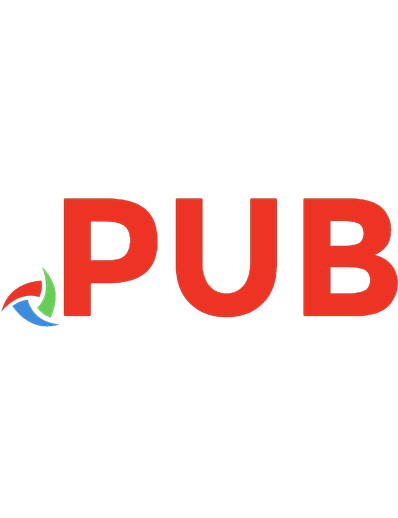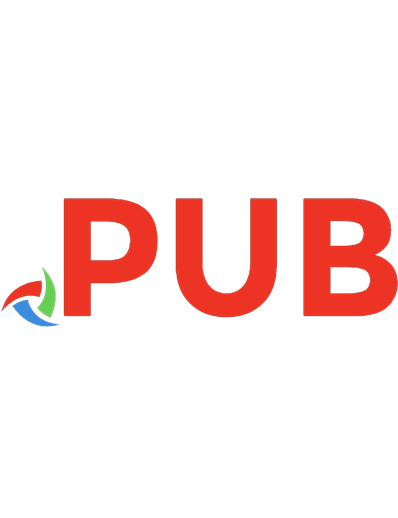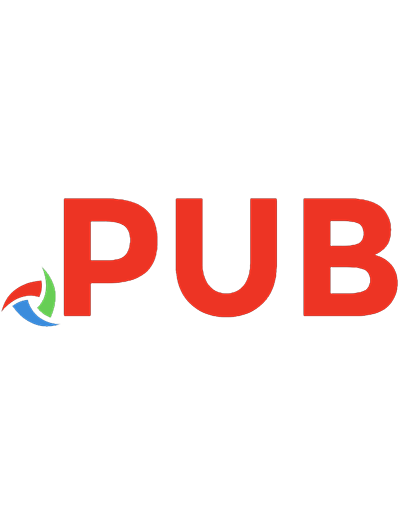Applied Quantum Computers: Learn about the Concept, Architecture, Tools, and Adoption Strategies 9789355510174
Explore the tools and concepts for Quantum Computing Key Features ● Offers a diverse range of perspectives from small
127 80 9MB
English Pages 694 Year 2023
Table of contents :
Cover Page
Title Page
Copyright Page
Dedication Page
Foreword
About the Author
About the Reviewer
Acknowledgements
Preface
Errata
Table of Contents
1. Tools for Imaginations, Innovation, Technologies, and Creativity
Structure
Objectives
Plan of the chapter
Mind Maps: An overview
Mind Map and brain
How to create a mind map
Point of View (POV)
Expert opinion
Jargon busters
Customer stories, case studies, and use cases
Industry bites
Thought cartoons / cartoons / TechToons
What are TechToons?
What are cartoons?
What are thought cartoons?
What are the differences between cartoons and TechToons?
Mind Map of the chapter
Conclusion
2. Quantum Physics as an Enabler of a Quantum Computer
Structure
Objectives
Introduction
Jargon Buster
From quantum information to quantum physics to quantum computer
Quantum computers?
Why do we need quantum physics for quantum computers?
Quantum 1.0 and 2.0
Quantum cryptography
Quantum computer and AI
Classical physics, modern physics, and quantum physics their relationships
The birth of quantum physics
Photons and quantum computers
What is photoelectric effect?... by the way
Let’s summarize: some fundamental concepts of modern physics and radiation
Particles of light
The event which triggered the modern thoughts: A bit of more history
Atomic theory
Foundation of quantum mechanics
Wave function
The Copenhagen interpretation
Quantum electrodynamics
Quantum personality: Richard P. Feynman
The fundamentals concepts of quantum computing
Superposition
Entanglement
Coherence
Decoherence
Fault tolerance
Interference
Tunneling
Randomness in behavior
Uncertainty principle and how it is useful in QC
Young’s double-slit experiment
The interrelation between entanglement and coherence
Before quantum physics, there is no law… right …!!!
The definition of quantum computers … revisited
Why quantum computers … now
Tell me how QC will work with today’s technologies
One of the major theories for quantum computers: The church-Turing Principle (CTP)
The discussion continues: Church-Turing Principle (CTP), quantum Turing machine and universal quantum computer
Universal quantum computer
The soul of quantum computers: The impact of algorithms
Quantum computing supremacy
Point of view: Seth Lloyd on Universe as QC
Quantum computing use cases
Sample opportunity areas for quantum computing: explanations for few important ones
The social and commercial effects of quantum technology
Story 1: quantum organization and leadership
Quantum computers: just a piece of a holistic system
Facts form research, innovation, and industry
Some questions and answers
Human brain and quantum computers: the QuBrain project
Mind Map for the chapter
Conclusion
References
Important terms for the chapter: refer to this when required
IT terminology
Qubits associated terminologies
3. Mathematics of Quantum Computers: The Fundamentals
Objectives
Structure
Introduction
Development of mathematics and physics
Quantum computers and mathematics
Number system
Euler’s formula
Some additional facts and types of number system
Structures in the number system
Polynomials
Number of systems in context of computer science
Details of computer’s relevent number systems
Details of the binary number system
Laws of Boolean algebra
Symbols
Truth tables for the laws of Boolean
Basic truth tables
Summary of Boolean algebra
Implications
Description of the laws of Boolean algebra
Boolean algebra functions
Use of Boolean algebra using its laws
Operands and operators in quantum mechanics
Importance of basic probability algebra and theory
Essential concepts of probability
Essential concepts of algebra
Review of Pythagoras theorem
Essential concepts of vectors
Vector addition and multiplication
Multiplying a Bra by a Ket
Concepts of matrices, different operations on matrices
Order of a matrix
Transpose of a matrix
Various common operations on matrices and their properties
Matrices addition
Matrices subtraction
Matrices multiplication
How to calculate?
Tensor and tensor product
Old wine in a new bottle!!!
Essential of trigonometry concepts
An important compilation of results related to Trigonometry and calculus
Quantum mechanics, quantum computers, and vectors
Observables and Hermitian operators
Jargon Buster
Mind Map for the chapter
Conclusion
4. From Bits to Qubits to Qubytes
Structure
Objective
Introduction
A miracle called quantum computers
Information theory, thermodynamics, and computation
The start of the journey: from then to now
Before we move further, some additional thoughts on a quantum computer
Quantum parallelism
Spin and Qubit
The physics of atom in a nutshell – facts and figures
Spin states and charges
Jargon box
Further details on state
What is this up and down state
How to get up and down state experientially
Significance of states
Summary of essential notions, math, and The Stern–Gerlach experimentbin context of Dirac theory
Qubit and entanglement
Spin
Quantum number and energy state
One additional point about Qubit and electron states
Electron spin theory
Observer effect
Observer effect, no-cloning theorem, and quantum computing
From classical bit to Qubit
Qubit detailed
Quick Facts
So how is the Qubit created?
Caution!!! More Qubit is not equal to faster computation
Systematic explanation of qubits, quantum gates, and circuits
How to measure Qubit
Quantum gates
From quantum gate to quantum circuit
Details of quantum circuts
Quantum register
Quantum register: working
Inputs and outputs of quantum circuits: representations, logic, and theory
Controlled gates
Measurement operator
A summary of the key symbols
Quantum teleportation and its circuit diagram
Let’s go into a bit detail: mechanics, mathematics, and measurements of Qubit
Single-Qubit gates
Few additional key single-qubit gates
Multi-Qubit gates
Universal sets: moving from traditional gates to Quantum gates
Multiple types of Qubit
Components of a Quantum computer
How to make robust quantum computers: welcome quantum error correction
A complete quantum system from hardware to software
Solving problems on quantum computers
Hybrid quantum – classical computing
Real-life working of Quantum Program: Microsoft way
Case Study: Microsoft’s journey to quantum computers
Other companies’ technology stacks
Question and answers
Story 1: Why Honeywell?
Honeywell challengers
Applications
Mind Map of the chapter
Conclusion
References
Important terms and concepts used in the chapter
5. Artificial Intelligence and Associated Technologies: A Review
Structure
Objective
Introduction
Intelligence and AI
The AI hypes
Can machines think?
Let’s define AI, ML
Why AI now?
The relevance of AI
Types of AI
Sometimes hard, sometimes soft: AI computing paradigm
What is Computational Intelligence (CI) and different variant of intelligent computing
AI research and its impact on the associated subsystems
Machine learning revisited
Machine learning types
Deep learning
Let’s build AI projects
AI, business of intelligence and the projects
The essential skills for AI projects
Does it mean managing AI projects are difficult?
Relation between AI, business, and perfect decision
Ingredients of a holistic AI solution: in the context of projects
How to create an AI solution
Cloud computing
Internet of Things (IoT)
What is big data?
Data, data and data: I want to know it in detail, but technically
Schema-on-write ecosystems
Schema-on-read ecosystems
Data lake
Data vault
Data analytics
Data science
Think holistically
Building IoT enabled AI
A pictorial real-life case study for IoT
Building Big data-based AI solution
The technology for Big data and AI
The advantages of HDInsight
Quantum computing and artificial intelligence?
OK, now I want to understand the interrelation between AI, ML deep learning, and quantum machine learning
Use cases for AI
Story 1: Future of humanity-- integration of Brain science, AI and quantum computers
Story 2: AI, culture, arts, and quantum computers
Story 3: The security of an AI is an emerging topic
Quantum use case 1: Quleap -- first integrated AI platform for small molecule drug design
Quantum use case 2: Hyrax – the quantum discovery framework
Hyrax
Quantum use case 3: Detecting market instabilities
Quantum use case 4: Optimizing radiotherapy treatments, fighting with cancer, and the quantum computing algorithm
Mind Map for the chapter
Conclusion
6. Quantum Algorithms for Everyone …!!!
Structure
Objective
Introduction
Adventures in quantum algorithms and problem-solving
A case of quantum algorithms
What is an algorithm by the way?
Types of algorithms
What are quantum algorithms
How Quantum Algorithms are different from the classical algorithm
Difficulties with the implementation of a quantum algorithms
Computational complexity
Complexity theory and Quantum computers
The quantum case of complexity and computation
Let’s program a quantum algorithm: Qiskit way
Quantum algorithms in action
A brief journey in the universe of quantum algorithm and computing
How to input data into a quantum computing algorithm using the quantum gate model
How quantum algorithms work
The big classes of quantum algorithms
Some important quantum algorithms
The Deutsch Oracle
Shor’s algorithm: Theoretical interaction
The Fourier transform: an introduction
Shor’s algorithm prime numbers: Generic interpretation of working
Working of Shor’s algorithm: Step wise explanation
Adiabatic algorithm
Topological-Quantum-Field-Theory (TQFT) Algorithms
Discrete-log
Verifying matrix products
Subset-sum
Grover’s algorithm
Uses of Grover’s algorithm
Setup steps of Grover’s algorithm
Steps of Grover’s algorithm
Explanation of the algorithm
Deutsch-Jozsa
Matrix commutativity
Group commutativity
Quantum simulation
Machine learning algorithms
Finally a summary of important facts about quantum algorithms
Quantum computing software platforms
Story 1: Semiconductor spin qubits for construction of reliable quantum computers
Story 2: Quantum compatible areas for algorithms
Story 3: Quantum computing and corporate traction
Provocative thought 1: Industries, quantum computers and way forward
Provocative thought 2: The case of the right quantum computer for business
Provocative thought 3: Industry transformation and quantum computers
Mind Map
Conclusion
References and bibliography
7. Quantum Machine Learning
Structure
Objective
Introduction
Building a business case for AI
The deal of quantum machine learning
Roadmap for building, executing, and running quantum machine learning
The current state of AI, ML, and deep learning technology
The democratization of artificial intelligence
Machine learning: libraries
Machine learning and deep learning platforms
Evolution of QML
Holistic approach towads QML and QC
Quantum machine learning and Quantum information processing
Classical machine learning versus quantum machine learning
Let’s explore QML
Quantum data
Hybrid quantum-classical models
Noisy Intermediate-Scale Quantum (NISQ)
Quantum speed-ups in machine learning
Author’s POV on building machine learning / Quantum machine learning solutions
Languages, Tools, Platforms, and QML
Quantum deep learning
Limits and discoveries in Quantum Deep Learning
Benefits of Quantum Machine Learning (QML)
Few important QML algorithms
A few important applications of QML
Algorthmic case study - Quantum Support Vector Machine (QSVM)
Story 1: Quantum imaging
Story 2: Quantum sensors a brief look
Story 3: Quantum simulation
Use case 1: LightOn’s optical processing unit
Use case 2: Quantum control
Use case 3: Chatbot and virtual assistants
Use case 4: Robotics in the context of AI and ML
Use case 5: 5G -- Present and future applications
Mind Map
Conclusion
Important terms and concepts used in the chapter
8. Quantum Cryptography: The Future of Security
Structure
Objective
Introduction
Need, shift, and desire for cryptography
The quantum computing threat to cryptography
The thesis of quantum cryptography
Understanding cryptography
Classical cryptography
Secret key cryptography
Public key cryptography
Limitations of classical cryptography techniques
Problem with cryptography
Importance of quantum cryptography
Quantum cryptography : in context of physics
Quantum cryptography versus traditional cryptography
Photon polarization and quantum cryptography
Polarization and polarizer
Measurement and polarization
Significance of quantum key distribution
Lattice-based cryptography
Hash-based cryptography
Fully distrustful protocol
Distrustful protocol
Bit commitment protocol
Some important other protocols
BB84 protocol
BB92 protocol
Cryptography attack
Quantum Internet
How to create a quantum network
Quantum internet consists of three essential quantum hardware elements
Quantum communications, Quantum Key Distrubution (QKD) and Quantum Internet
Quick Facts
Pros and cons of expanding cryptographic infrastructure
Teleportation
Blockchain
Bitcoin, Blockchain and their working
Blockchain: the perfect partner for AI data
Meeting the challenge--capturing the opportunity
Quantum Blockchain
How likely is a quantum attack on bitcoin?
Quantum networks and classical digital networks: impact and advantages in brief
Future-ready: quantum cryptography and its influence in comming time
Story 1: Quantum computing-based recommendation systems
Story 2: Disease spread, bacterial growth, and QC
Story 3: How quantum computers will transform travel
Story 4: Quantum computer and personalized customer experience
Use case 1: Quantum prediction
Use case 2: Caixa Bank journey to grow risk classification model through quantum computing
Use case 3: Quantum computing and the automobile industry
Latest research: path to quantum computing at room temperature
Mind Map
Conclusion
References
9. The Architecture of a Quantum Computer
Structure
Objective
Introduction
Different views of QC architecture
A review of concepts: in the context of quantum architecture
A brief of quantum computation
Journey of Qubit
The scale of operation
Bloch’s Sphere: a mathematical representation of the Qubit
Additional facts about quantum gate
A review of quantum hardware
General discussion on Core Qubit technologies development: in the background of history
The desire of building a quantum computer
Architecture of QC
General discussion on QC
Quantum annealing and computers
Quantum simulations
Universal quantum computing
Multiple types of Qubit technologies
Topological QC
Superconductor-based QC
Trapped ion QC
Quantum dot QC
Nuclear magnetic resonance QC
Diamond-based QC
Photon-based QC
Few additional important technologies for quantum computers and Qubits
Let’s build a quantum computer: elements of a quantum processor
Practicalities of quantum computers
The simplest way to build a quantum computer
Entangled photons detection: Challenges and resolution
Baby steps for quantum architecture
Startup stories: D-Wave revisited
Story 1: Quantum chemistry
Story 2: Quantum compilers
Story 3: Quantum computer a developmental journey: adiabatic quantum computer
Use case 1: Material design and quantum computer
Use case 2: Let’s do the optimization: The QC way
Use case 3: Development of new molecules and materials
Mind Map
Question and answers
Conclusion
10. DNA, Quantum and Photonic Computers
Structure
Objective
Introduction
Some new types of computing
A journey to the world of quantum, DNA and optical computing through AI
Quantum machines, computers, and AI
Optical computing, deep learning and AI
DNA computers and AI
The drive of DNA computing
DNA and DNA computing: Details
About Traveling Salesman Problem (TSP)
DNA computers: In context of traveling salesman problem
The advantages of DNA computing
How long will it take for DNA computers to arrive?
Optical computing: a journey
Understanding the optical computer
Benefits of optical computing
Not so good about optical computing
Details of optical computing
Laser transistor and optical computer
Present and future of photonics in the context of optical computing
Optical processor architecture
Microsoft and programming Biology
Automation of DNA and Microsoft
Can we have a DNA-based computer act as a Quantum Computer too? If yes, then how? If no, then why not?
How quantum, DNA and optical computers would work together?
Question and answers
Mind Map
Conclusion
11. Let’s Realize It: Quantum Start-Ups and Giants in Action
Structure
Objective
Introduction
A story of startups
The generation of start-up and giants collaboration
Zapata
Cambridge quantum computing
Generative Tensorial Networks (GTN)
Entropic labs
HQS quantum simulations
ProteinQure
ProteinQure brings quantum-classical hybrid approach to protein design
A collaborative effort of ProteinQure: Rigetti Computing and ProteinQure
QC Ware
Strangeworks
Amazon quantum solutions lab
A few highlights for Amazon quantum initiatives
Microsoft
Quantum computing at IBM
Intel
Rigetti computing
The patent journey of quantum computing companies
Patent 1: Accenture US patent for quantum computing – distribution of work effectively on classical/traditional versus quantum computer
Patent 2: Analog processor comprising quantum devices (10691633)
Patent 3: Quantum computing integrated development environment (US20030121028)
Mind Map
Conclusion
12. The Quantum Strategies
Structure
Objective
Introduction
A new way of doing business
Quantum computing for getting business edge
The risk of ignoring quantum computing
Democratization of technology and race for quantum supremacy
Datanomics, AI, and QC
The realities of quantum computing
Innovation, disruptions, business expectations and quantum computing
Quantum software strategies
Seizing quantum advantage for your business
CIOs, business value, and quantum computing
Business barriers
Quantum computing market structure
Market forecasts
Opportunities to apply quantum computation on industry
Innovating with quantum computing now
Let’s be agile … in context of quantum computing incentives and machine learning (applicable for QML as well)
Why do you need agile?
Waterfall methodology
Pit bits
Agile disadvantages
Agile usage
Growth values
Personal values
Short- and long-term goals for corporates and additional thoughts on quantum strategies
Mind Map
Conclusion
13. The Human Side of Quantum Computer
Structure
Objective
Introduction
Interrelation of creativity and quantum computing
Agility and modern organization
Meaning of organizational agility
Emotional, social, and moral intelligence
Benefits of equipping technical teams with EQ and other behavioral competencies
Innovations and innovative mindset
Flexibility
Creativity
Holistic and bigger thinking
Courage
Quick action
Skills requirements for QC team
Additional and specific skills requirements of QC for an individual
How to build a quantum team
Qualities of great quantum team members
Difference between leader and manager
How to build data culture and train resource on innovative technologies
Important roles and dimentions of a quantum team
Team leader
Team members
Technology / Engineering manager
Organizational Leaders
Questions for transparency
POV
Mind Map
Conclusion
Annexure 1: Q# for quantum computation
Q# features
Q# Libraries
Annexure 2: Python for Quantum computing
Vectors, matrices, and tensors manipulations
Arithmetic operations in Python
Vector and matrix properties and python
Annexure 3: Miscellaneous topics: reduction in emissions, global warming, fearless leadership and important facts
Annexure 4: References, Notes and Bibliography
Index









